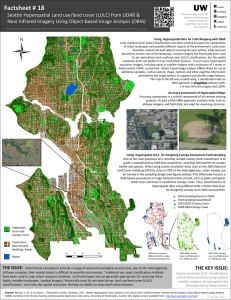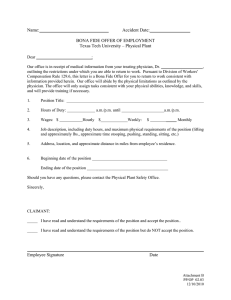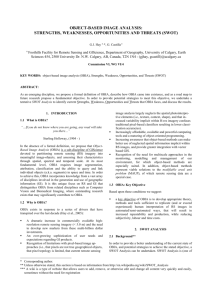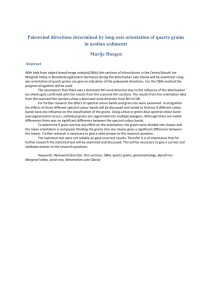SPATIAL ACCURACY ASSESSMENT OF OBJECT BOUNDARIES FOR OBJECT-BASED IMAGE ANALYSIS
advertisement
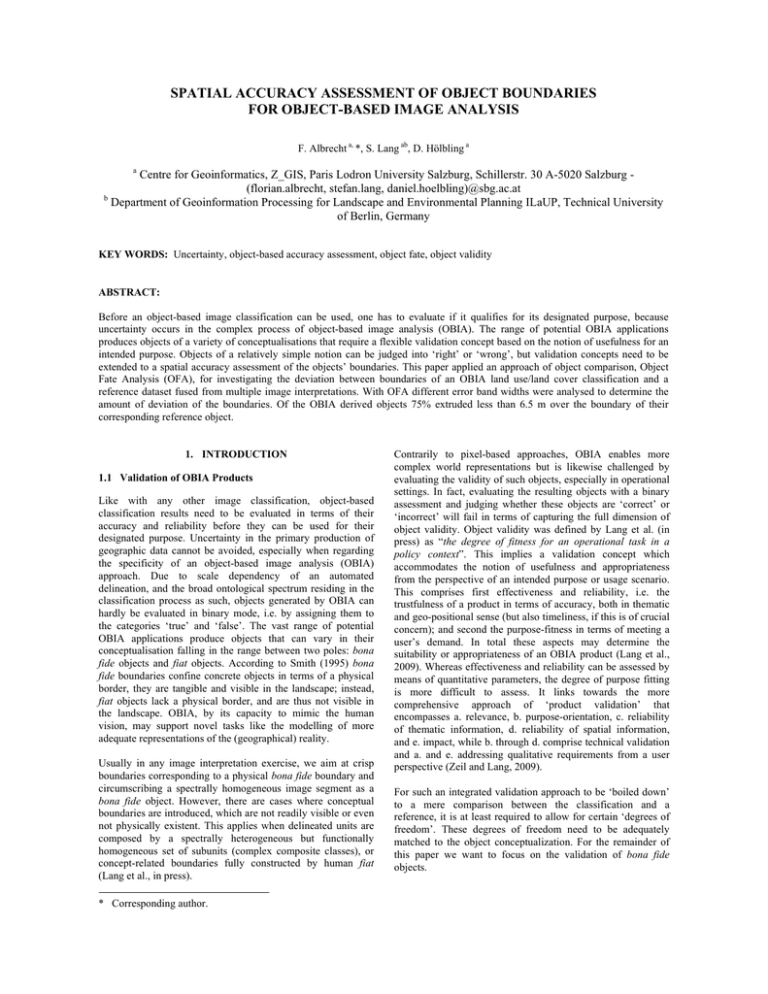
SPATIAL ACCURACY ASSESSMENT OF OBJECT BOUNDARIES FOR OBJECT-BASED IMAGE ANALYSIS F. Albrecht a, *, S. Lang ab, D. Hölbling a a Centre for Geoinformatics, Z_GIS, Paris Lodron University Salzburg, Schillerstr. 30 A-5020 Salzburg (florian.albrecht, stefan.lang, daniel.hoelbling)@sbg.ac.at b Department of Geoinformation Processing for Landscape and Environmental Planning ILaUP, Technical University of Berlin, Germany KEY WORDS: Uncertainty, object-based accuracy assessment, object fate, object validity ABSTRACT: Before an object-based image classification can be used, one has to evaluate if it qualifies for its designated purpose, because uncertainty occurs in the complex process of object-based image analysis (OBIA). The range of potential OBIA applications produces objects of a variety of conceptualisations that require a flexible validation concept based on the notion of usefulness for an intended purpose. Objects of a relatively simple notion can be judged into ‘right’ or ‘wrong’, but validation concepts need to be extended to a spatial accuracy assessment of the objects’ boundaries. This paper applied an approach of object comparison, Object Fate Analysis (OFA), for investigating the deviation between boundaries of an OBIA land use/land cover classification and a reference dataset fused from multiple image interpretations. With OFA different error band widths were analysed to determine the amount of deviation of the boundaries. Of the OBIA derived objects 75% extruded less than 6.5 m over the boundary of their corresponding reference object. 1. INTRODUCTION 1.1 Validation of OBIA Products Like with any other image classification, object-based classification results need to be evaluated in terms of their accuracy and reliability before they can be used for their designated purpose. Uncertainty in the primary production of geographic data cannot be avoided, especially when regarding the specificity of an object-based image analysis (OBIA) approach. Due to scale dependency of an automated delineation, and the broad ontological spectrum residing in the classification process as such, objects generated by OBIA can hardly be evaluated in binary mode, i.e. by assigning them to the categories ‘true’ and ‘false’. The vast range of potential OBIA applications produce objects that can vary in their conceptualisation falling in the range between two poles: bona fide objects and fiat objects. According to Smith (1995) bona fide boundaries confine concrete objects in terms of a physical border, they are tangible and visible in the landscape; instead, fiat objects lack a physical border, and are thus not visible in the landscape. OBIA, by its capacity to mimic the human vision, may support novel tasks like the modelling of more adequate representations of the (geographical) reality. Usually in any image interpretation exercise, we aim at crisp boundaries corresponding to a physical bona fide boundary and circumscribing a spectrally homogeneous image segment as a bona fide object. However, there are cases where conceptual boundaries are introduced, which are not readily visible or even not physically existent. This applies when delineated units are composed by a spectrally heterogeneous but functionally homogeneous set of subunits (complex composite classes), or concept-related boundaries fully constructed by human fiat (Lang et al., in press). * Corresponding author. Contrarily to pixel-based approaches, OBIA enables more complex world representations but is likewise challenged by evaluating the validity of such objects, especially in operational settings. In fact, evaluating the resulting objects with a binary assessment and judging whether these objects are ‘correct’ or ‘incorrect’ will fail in terms of capturing the full dimension of object validity. Object validity was defined by Lang et al. (in press) as “the degree of fitness for an operational task in a policy context”. This implies a validation concept which accommodates the notion of usefulness and appropriateness from the perspective of an intended purpose or usage scenario. This comprises first effectiveness and reliability, i.e. the trustfulness of a product in terms of accuracy, both in thematic and geo-positional sense (but also timeliness, if this is of crucial concern); and second the purpose-fitness in terms of meeting a user’s demand. In total these aspects may determine the suitability or appropriateness of an OBIA product (Lang et al., 2009). Whereas effectiveness and reliability can be assessed by means of quantitative parameters, the degree of purpose fitting is more difficult to assess. It links towards the more comprehensive approach of ‘product validation’ that encompasses a. relevance, b. purpose-orientation, c. reliability of thematic information, d. reliability of spatial information, and e. impact, while b. through d. comprise technical validation and a. and e. addressing qualitative requirements from a user perspective (Zeil and Lang, 2009). For such an integrated validation approach to be ‘boiled down’ to a mere comparison between the classification and a reference, it is at least required to allow for certain ‘degrees of freedom’. These degrees of freedom need to be adequately matched to the object conceptualization. For the remainder of this paper we want to focus on the validation of bona fide objects. The International Archives of the Photogrammetry, Remote Sensing and Spatial Information Sciences, Vol. XXXVIII-4/C7 1.2 Uncertainty in the Object Identification Process As mentioned above, bona fide objects are objects with a physical boundary that are perceived by people in more or less the same way (Smith, 1995). The objects follow a relatively simple notion, and consequently, a common understanding exists for them (ibid.). Therefore, the label (i.e. the class assignment) of such an object can be judged as either right or wrong. This is extendable to a certain degree to the object boundary that can be right or wrong, too, when allowing for a limited amount of variation. The boundaries of these objects differ due to scale and generalisation. When interpreters delineate an object, e.g. a forest, in an image with a fixed resolution they are likely to operate in a similar scale domain, applying some generalisation to achieve it. For a large number of interpreters this would result in many different delineations, each deviating from each other showing a specific level of detail. We hypothesise, however, that these delineations would fall into a common scale domain, and therefore, a representative delineation of the set of delineations can be derived. Such a ‘mean’ delineation, generated for example by constructing the centre line of the set, would have a commensurate scale and generalisation level which all interpreters commonly agree upon. A common representation of the bona fide object therefore is also possible for the boundary, at least to a certain degree as a theoretically achievable goal (the ‘mean’ interpretation), or as a band of allowed deviation (fuzzy band width around a mean interpretation). When bona fide objects are extracted from remotely sensed data uncertainties occur in the OBIA process. OBIA products are representations of ‘reality’ and are filtered in some or the other way. Zhang and Goodchild (2002) subdivide the object identification process in conceptual abstraction and physical extraction, which can be extended for OBIA by a step of intelligible expression (cf. Figure 1). The newly inserted filter results in a machine-understandable description that, in such a form, is not required for manual image interpretation. Each filter adds its own inherent uncertainty. When an object-based classification is created the displayed process follows a cyclic manner. The result of each identification step is improved by reducing uncertainty in the step before until the extracted objects satisfy the intended purpose. Although bona fide objects are conceptually quite clear, there still are uncertainties present when their representations are extracted from image data. For the validation of bona fide objects the main challenge is currently to account for fuzziness in the boundaries due to scale and generalization issues (Lang et al., in press). Research has been conducted on exploring and handling uncertainty in boundaries of geographic objects (Burrough and Frank, 1996), e.g. by applying fuzzy set theory (ibid.). Fuzzy boundary widths have been estimated for forest stands by evaluating the uncertainty in the boundary deviation of multiple image interpretations (Edwards and Lowell, 1996). Schiewe et al. (2009) have applied fuzzy set theory for the estimation of indeterminate transition zones along boundaries for an improved accuracy assessment of remote sensing classifications. In this study an OBIA classification is validated by comparing it to a reference dataset that was fused from multiple visual image interpretations. The method of Object Fate Analysis (OFA) was applied for evaluating the correspondence between objects of two representations on the object level (Tiede et al., 2010). We propose OFA as a method for validating OBIA classifications and present its capability to evaluate boundary uncertainty in bona fide objects. Figure 1. The OBIA object identification process (Albrecht, 2008; modified) 2. DATA 2.1 Case Study Arrangement In order to investigate the validation of an OBIA classification with visual image interpretation a task has been designed for the development of a land use/land cover map based on aerial photography. It included examples of the designated use of the product and associated quality requirements. The task was open to different object extraction methods. An OBIA classification was produced, as well as visual image interpretations. For an area in the community of Plainfeld, Austria (cf. Figure 2), a land use/land cover map was generated based on an orthophoto with 0.5 m spatial resolution. The predefined classification scheme contained the classes building, garden, road, farmland, and forest. These classes are commonly understood and result in bona fide objects. Classes like shadow, other, or uncertain could be included optionally. Figure 2. Study area Plainfeld, Salzburg, Austria The International Archives of the Photogrammetry, Remote Sensing and Spatial Information Sciences, Vol. XXXVIII-4/C7 2.2 OBIA Classification Approach 2.3 Visual Image Interpretations Object-based land use/land cover (LULC) classification was carried out on the basis of the aerial orthophoto, which consists of three visible bands (RGB) and shows a spatial resolution of 0.5 meters. The semi-automated, cyclic process of segmentation and classification (‘class modelling’; cf. Tiede et al., 2010), was performed through the development of an expert rule set in CNL (Cognition Network Language) in the eCognition Developer 8 software environment. A multi-resolution segmentation approach has been used for providing spatial units. The applied segmentation parameters (Scale Parameter 30; Shape 0.3; Compactness 0.6) approved as suitable for the delineation of buildings and roads, though led to a slight oversegmentation in some areas of the underlying image, e.g. farmland or forest. The final image object boundaries were derived by further refinements through the implementation of grow and merge functions during class modelling process. Spectral (mean, standard deviation, ratio etc.) and shape characteristics (length/width, compactness, density etc.) were applied throughout the rule-based classification. Additionally, context information was used for determining the class garden. More precisely objects classified as garden had to lie within a certain distance to buildings. Due to the missing near-infrared band the differentiation between non-vegetation and areas with sparse vegetation (e.g. harvested/ploughed fields or clearings) was slightly aggravated. Thus, for avoiding false positives in terms of too many objects classified as non-vegetation, the option of working with regions and maps in eCognition Developer 8 has been used. By defining regions of interest, each covering one of the small settlements or farmhouses, and copying them to separate maps, it was possible to process these specific areas individually. So, classification and, if necessary, image object resizing algorithms were performed in each of the defined regions. Finally, the refined objects of interest were synchronizing back to a main map. The classification result distinguishes the six classes building, road, garden, farmland, forest and shadow (Figure 3). For obtaining the visual image interpretations the described task was accomplished in a course on data acquisition in UNIGIS, a postgraduate distance-learning MSc programme for GIS specialists at the Centre for Geoinformatics, Salzburg. The students were provided with an introduction to the topic of uncertainty and scale in digitising. This included the advice to produce the interpretation at a fixed image resolution. A sample interpretation was available for a part of the study area serving as a reference for the to-be achieved accuracy and generalisation. Ancillary data included the cadastre and the topographic map ÖK50 with a scale of 1:50,000. From the course twenty-two image interpretations were available for further analysis. In Figure 4 the deviation of the boundaries becomes obvious especially for the forest objects. The students also applied a different amount of generalization, so that some boundaries follow the borders of the objects in a very detailed fashion whereas others do this in a coarse manner (Lang et al., in press). Figure 4. Overlay of the students’ interpretations. Colour shades indicate the land use/land cover classes of the majority of the interpretations 3. METHODS 3.1 Preparation of Median Interpretation A reference dataset was generated out of the image interpretations that seemed to be most suitable for the comparison to an OBIA classification (Albrecht, in press). The OBIA classification showed very detailed object boundaries and required an adequately detailed reference. Consequently, from the visual image interpretations the ones with a too high amount of generalisation were discarded. Figure 5 opposes (a) the generalised interpretations with (b) the detailed interpretations. Figure 3. OBIA classification of the study area The remaining interpretations (eleven out of twenty-two) were fused to one median interpretation by evaluating the thematic agreement between the datasets. For every segment in the overlay of the interpretations the class was assigned that had been selected most frequently. Yet undecided segments were The International Archives of the Photogrammetry, Remote Sensing and Spatial Information Sciences, Vol. XXXVIII-4/C7 pragmatically counted to the class with the lower class ID. By merging segments with the same class labels a dataset resulted where the object boundary fell in the middle of the sliver polygons that cluster in the boundary region. The sliver polygons were parted equally on either side. As the calculated boundary also parted the number of delineations in half, the dataset subsequently is called median interpretation. For a visual comparison the median interpretation was not only calculated for the detailed interpretations but also for the discarded generalised interpretations. In Figure 5 both datasets are displayed underlain by the corresponding interpretations. ‘extrusion’, Rex, in equation (1). Complementary, the ratio of ‘intrusion’, Rint, presented in equation (2), was computed by comparing the number of objects intersecting the inside buffer (invading objects) to the objects that remained outside of it (not interfering objects). For each buffer size the categorisation was applied iteratively for all reference objects. Rex = Rint = Figure 5. Forest object with (a) generalised delineations and (b) detailed delineations, displaying the corresponding median interpretation in yellow 3.2 Object Fate Analysis For an accuracy assessment of a map being produced by OBIA the units to be tested are the image objects. Therefore, the OBIA classification is validated with the median interpretation, i.e. the reference, by applying OFA, a method that compares the boundaries of two representations on the object level. The concept of OFA is implemented in a tool called LIST (Landscape Interpretation Support Tool), that is available as an extension for ESRI’s ArcGIS 9 (Schöpfer et al., 2008) and allows for object quantification and the complementation of visual interpretation. With OFA, the tool also provides a method for investigating the deviation between boundaries of corresponding objects originating from different representations. These could be different delineation methods (visual interpretation vs. automated extraction), or changes that objects have undergone from one point in time to another. OFA has been successfully applied for change detection in landscape analysis, where ‘object fate’ is evaluated for the behaviour of landscape objects over time (Schöpfer et al., 2008) and for spatial accuracy assessment (Tiede et al., 2010). OFA evaluates the deviation of objects resulting from OBIA classification to their reference objects by categorizing the topological relationship with an error band as follows: by applying buffers with increasing width to the reference object as an epsilon error band (Zhang and Goodchild, 2002), the deviation of every corresponding, or adjoining, object of the OBIA classification was measured. All OBIA classification objects overlapping a specific reference object were distinguished into adjoining or corresponding objects by the position of their centroid, outside or inside of the reference object. This approach differentiates the topological relationship between the compared objects into the clusters ‘similar to disjoint’ (C1) and ‘similar to equal’ (C2) (Straub and Heipke, 2004). Relationships of cluster C1 were investigated with a buffer to the inside of the reference object, relationships of cluster C2 with a buffer to the outside. For cluster C2, the number of objects intersecting the outside buffer (expanding objects) was counted and compared to the number of objects that remained inside of it (good objects) by the ratio of nexp (1) ngood + nexp ninv ninv + nn _ int (2) where n is the total number of relationships occurring within a specified category, for all comparisons between the OBIA classification objects and the reference objects (Schöpfer et al., 2008; equations modified). The complete logic of the OFA categorisation process is illustrated in Figure 6. The object categories good and not interfering were further separated into two sub-categories by applying a buffer of size zero. Figure 6. Categorisation of the interaction between image interpretation objects and reference objects (Schöpfer et al., 2008) 4. RESULTS OFA was applied to the two compared datasets for a range of buffer sizes (Figure 7). The behaviour of the ratios Rex and Rint was observed to determine the error bandwidth that best describes the deviation of the boundaries. The International Archives of the Photogrammetry, Remote Sensing and Spatial Information Sciences, Vol. XXXVIII-4/C7 classification were successfully validated with a reference dataset that was fused from multiple image interpretations by retrieving a median interpretation. With OFA it was possible to measure the deviation of classification object delineations from the reference object delineations. The method of OFA still needs strengthening of the applied analysis techniques for the categorisation. The approach also has to be extended to consider thematic content. Although the method of OFA is not yet mature, it is already flexible enough to be applied in the validation of more complex object boundaries, such as objects of complex OBIA products located closer to the pole of fiat objects. ACKNOWLEDGEMENTS The study was based on the image interpretations prepared by the UNIGIS MSc 2009 students. The authors also thank Stefanie Wirth for her support in analysing the data. Figure 7. Behaviour of the ratios (a) Rex and (b) Rint with increasing buffer distance For the study area of Plainfeld the OBIA classification, consisting of 221 polygons, was compared to the median interpretation, consisting of 124 polygons. This resulted in 533 C1 relationships and 205 C2 relationships. Buffer sizes from 0 to 30 meters in 0.5 meter steps have been applied and Rex and Rint have been calculated (cf. Figure 8). REFERENCES Albrecht, F. 2008. Assessing the spatial accuracy of objectbased image classifications. In: Car, A., Griesebner, G, Strobl, J (ed.) GI_Forum '08. Salzburg, Austria: Wichmann Verlag. Albrecht, F. in press. Uncertainty in image interpretation as reference for accuracy assessment in object-based image analysis. Ninth International Symposium on Spatial Accuracy Assessment in Natural Resources and Environmental Sciences. Leicester, United Kingdom. Burrough, P. A., A. U. Frank 1996. Geographic objects with indeterminate boundaries, London, Bristol, Taylor & Francis. Edwards, G., K. E. Lowell 1996. Modeling uncertainty in photointerpreted boundaries. Photogrammetric Engineering and Remote Sensing, 62, 377-391. Lang, S., F. Albrecht, S. Kienberger, D. Tiede in press. Object validity for operational tasks in a policy context. Journal of Spatial Science. Figure 8. Ratios Rex and Rint of the OFA calculation for the OBIA classification in comparison to the median interpretation As it can be derived from Figure 8, the buffer size at Rex = 0.25 was 6.5 m. Therefore, 75% of the OBIA classification objects did extrude less than 6.5 m across the boundary of their corresponding reference object. The buffer size at Rint = 0.25 was 3.5 m. The buffer size at Rex = 0.1 was 20 m and at Rint = 0.1 it was 7 m. Generally, there occur lower values of Rint compared to the values of the ratio Rex. 5. CONCLUSION As the application of OBIA methods may result in objects of diverging comprehension, a suitable validation concept is required that evaluates the OBIA product from the perspective of an intended purpose. Even for bona fide objects of a relatively clear conceptual shape the assessment needs to allow for certain degrees of freedom related to fuzziness in the boundary. In this study the object boundaries of an OBIA Lang, S., F. Albrecht, A. Osberger 2009. Accuracy vs. appropriateness - assessing spatial qualities of product validity in a crisis mapping context. In: Corbane, C., Broglia, M., Carrion, D., Lemoine, G., Pesaresi, M. (eds.) VALgEO International workshop on validation of geo-information products for crisis management. Ispra, Italy: European Communities. Schiewe, J., M. Ehlers, C. Kinkeldey, D. Tomowski 2009. Implementation of Indeterminate Transition Zones for Uncertainty Modeling in Classified Remotely Sensed Scenes. In: Haunert, J.-H., Kieler, B., Milde, J. (eds.) 12th AGILE International Conference on Geographic Information Science 2009. Hannover, Germany. Schöpfer, E., S. Lang, F. Albrecht 2008. Object-fate analysis: Spatial relationships for the assessment of object transition and. In: Blaschke, T., Lang, S., Hay, G. J. (eds.) Object-Based Image Analysis : Spatial Concepts for Knowledge-Driven Remote Sensing Applications. Berlin, Heidelberg: SpringerVerlag. The International Archives of the Photogrammetry, Remote Sensing and Spatial Information Sciences, Vol. XXXVIII-4/C7 Smith, B. 1995. On drawing lines on a map. In: Frank, A. U., Kuhn, W., eds. International Conference on Spatial Information Theory - A Theoretical Basis for GIS (COSIT 95), Sep 21-23 1995 Semmering, Austria. BERLIN 33: Springer-Verlag Berlin, 475-484. Straub, B. M., C. Heipke 2004. Concepts for internal and external evaluation of automatically delineated tree tops. International Archives of Photogrammetry and Remote Sensing, 26, 62-65. Tiede, D., S. Lang, F. Albrecht, D. Hölbling 2010. Object-based Class Modeling for Cadastre-constrained Delineation of Geoobjects. Photogrammetric Engineering and Remote Sensing, 76, 193-202. Zeil, P., S. Lang 2009. Do have clients a role in validation? In: Corbane, C., Broglia, M., Carrion, D., Lemoine, G., Pesaresi, M. (eds.) VALgEO - International workshop on validation of geo-information products for crisis management. Ispra, Italy: European Communities. Zhang, J. X., M. F. Goodchild 2002. Uncertainty in Geographical Information, New York, Taylor and Francis.

